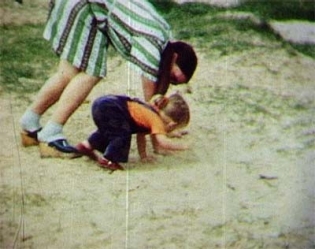Found footage can be seen in a number of films in this series, as well as in notable Eastern European films that fall outside its purview, such as Andrei Tarkovsky’s The Mirror, which incorporates newsreel footage into a loosely autobiographical fiction film. Just as filmmakers appropriated and used existing footage for varied reasons, so their sources varied widely. In this series alone, sources include older films borrowed almost whole cloth (Innocence Unprotected) and newsreel and television coverage of significant historical events (Innocence Unprotected; Clapper; Personal Cuts). Other films borrow advertising-style propaganda (Hello, Berlin!) and amateur home movies dating back to the 1930s (Private History). Indeed, Gábor Bódy’s Private History, a “compilation of amateur movies, most of them made by Budapest’s Jewish bourgeoisie during the late thirties and early forties,"[1] is notable as a source of inspiration for the Hungarian director Péter Forgács, whose films have previously been shown at the Gallery and are the best-known found-footage films to come out of Eastern Europe.[2] Over his long career, Forgács has created a series collectively titled Private Hungary that uses home movies from the 1930s through the 1960s to reconstruct his country’s traumatic national history through numerous personal stories.[3]
Banner stills from The Flipside of the Coin, courtesy Riga Film Museum
Found Footage and Home Movies

Still from The Flipside of the Coin, courtesy Riga Film Museum
The desire to reexamine traumatic collective memories and histories through personal histories and images of everyday life has motivated some of the most poignant uses of found footage in postwar cinema. The critic J. Hoberman noted this in 1982 when, writing about Bódy’s Private History, he juxtaposed it with other examples drawn from “an international avant-garde,” including “the work of Bruce Conner [and] even more specifically, Ken Jacobs’s 1975 Urban Peasants (an assemblage made from the home-movies of Brooklyn’s Jewish petite bourgeoisie).” Hoberman also suggested that Bódy’s film is a “historical reconstruction . . . anticipating Edgardo Cozarinsky’s evocation of occupied Paris, One Man’s War (1982)."[4] Another parallel is Stuart Cooper’s Overlord (1975), which combines documentary footage with a fictional narrative to create “both a document of World War II and a dreamlike meditation on human smallness in a large, incomprehensible machine.”

Still from The Flipside of the Coin, courtesy Riga Film Museum
What distinguished Bódy’s film from its Western counterparts in Hoberman’s eyes was that it “[set] out to exhume and perhaps illuminate a buried chapter of Hungarian history”—namely, the history of the Holocaust, which Forgács, too, has continued to explore.[5] The wish to narrate a long-concealed history also drives Romualds Pipars’ and Maija Selecka’s The Flipside of the Coin, a feature-length film that shows the continuity between films created during the socialist era and films that respond to that era today. The Flipside of the Coin addresses the history of postwar Latvia, whose forcible joining to the Soviet Union remained an officially taboo topic in the country until 1991. To illuminate the national trauma through images of everyday life, the filmmakers collected and edited amateur home movies to create almost two hours of footage, giving it new life by adding sound to the originally silent scenes, thus making the evocation of the past intensely immediate. Breaking with the conventions of most earlier found-footage films, they also added voiceover narration, which speaks directly to their aims and strives to contextualize the footage. The story they tell is thus both far less ambiguous and far more potentially contentious than most earlier films that made use of found footage, yet it speaks to the continued significance of this approach to examining the relevance of the past to the present. — Ksenya Gurshtein
1. J. Hoberman, “The Leading Role: Hungarian Documentary and the BBS,” in BBS Budapest: Twenty Years of Hungarian Experimental Film (New York, 1985), 12. (back to top)
2. Forgács started his career at the Balázs Béla Studio [LINK], which, in addition to Gábor Bódy, had a surprisingly large number of other filmmakers who were interested in the uses of found footage. They include, among others, Dezső Magyar and his film Punitive Expedition (1970), Péter Tímár and his film Film Analysis (Mozgókép Analízis) (1976), János Tóth, András Szirtes, and Dóra Maurer. (back to top)
3. For a collection of essays on Forgács’ works, see Bill Nichols and Michael Renov, eds., Cinema’s Alchemist: The Films of Péter Forgács (Minneapolis, 2011). (back to top)
4. J. Hoberman, “The Leading Role: Hungarian Documentary and the BBS” in BBS Budapest: Twenty Years of Hungarian Experimental Film (New York, 1985), 12. (back to top)
5. Ibid. (back to top)
